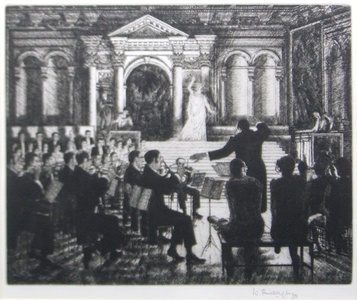| Method | Etching |
| Artist | Wilfred Fairclough |
| Published | July 1973 |
| Dimensions | Image and Plate 245 x 310 mm |
| Notes |
Signed and dated in pencil Lowe 81 Lowe records four impressions in three states Juditha Triumphans is an oratorio written un 1716 by Vivaldi. The Scuola Grande di San Rocco was a charitable confratenity dedicated to the relief of victims of the plague and dedicated to St. Roc or Roche Best known for the decorations Tintoretto in the Sala dell'Albergo, the Scuola as always been used as a concert venue. Born in Lancashire, he left school at fifteen and worked with a firm of accountants. In 1925 he attended evening classes at Blackburn School of Arts and Crafts. In 1930, after qualifying in art through evening classes, Fairclough began teaching part-time. Finding a copy of E.S.Lumsden's 'The Art of Etching', he taught himself how to etch. He attended the Royal College of Art between the years 1931-34, when Austin, Osborne and Brockhurst among others, were teaching there. It was Prof. Malcolm Osborne who helped him get another grant for a year so he was able to complete his three year course. Without this grant Fairclough could not have continued at the college( Both his parents having died when he was young). In 1934 he was elected as an associate to The Royal Society of Painters-Etchers. He won the Rome Scholarship, after being recommended by Osborne and Austin. It was in the same year that one of his etchings appeared in the annual publication 'Fine Prints of the Year'. Although there were no teachers, the facilities at the School in Rome were excellent and he worked hard; his application for another year was accepted. This time instead of working in Italy he travelled around Spain (1935-36). On his return to the British School at Rome, there he met Andrew Freeth, Cowern and Murray Todd. At the end of 1937, he found work teaching architectural drawing at London Northern Polytechnic and part time teaching at Kingston upon Thames Art School. In 1939 he was engaged by Palmer to contribute drawings for 'Recording Britain':he contributed a total of 58 drawings. By the early 1950's he had almost stopped etching. However, in 1961 at the age of fifty-four, he received the Leverhulme Research Award and he returned to Italy for the eight week summer holiday break. In 1962 he became the Principal of Kingston College of Art and Assistant Director of the Kingston Polytechnic. He was made Head of the Division of Design in 1970, retiring two years later. He produced 140 plates in his lifetime. Being perhaps best known for his Venice carnival scenes |
| Framing | mounted |
| Price | £350.00 |
| Stock ID | 11514 |

